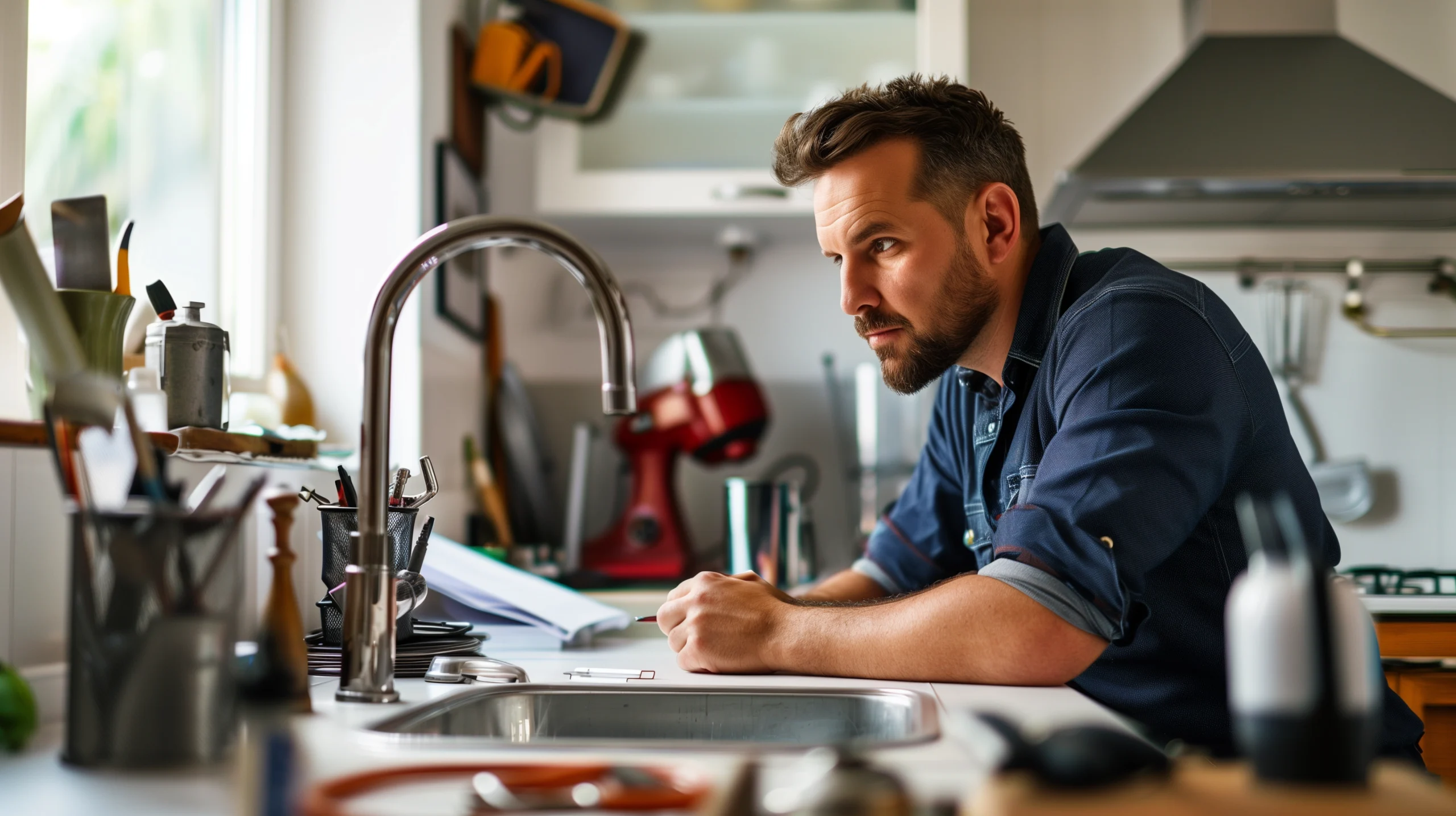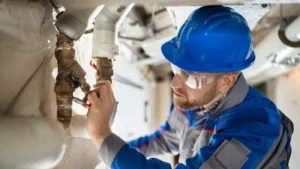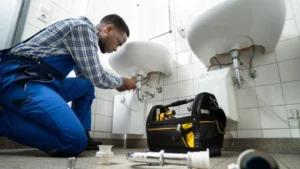Want to win more jobs with less effort?
Grow your business and send quick quotes with our home service software.

Want to see your potential revenue?
See what businesses like yours earn with Housecall Pro in 1 - 2 minutes.

Pricing plumbing jobs isn’t just about crunching numbers—it’s about knowing your market and protecting your bottom line. Material costs change, every property comes with surprises, and one wrong estimate can eat into your profits. Price jobs right, and you’ll stay competitive while earning customer trust through transparency.
This plumbing pricing guide covers average hourly rates, service call fees, job-based pricing, and a repeatable estimating process. You’ll also learn how Housecall Pro’s plumbing software automates quotes, pricing, and scheduling so you can focus less on admin and more on growth.
Tired of guessing what to charge? Download our free Plumbing Price Book Template to set accurate, consistent prices in minutes → Grab the template
Key takeaways
Here are five key insights for profitable plumbing pricing:
Know your rates: Most plumbers charge $80–$130 per hour, with commercial closer to $100+ per hour.
Separate fees: Always charge a service/diagnostic fee to cover travel and time.
Factor in access: Hard-to-reach pipes or slab work justify higher quotes.
Update often: Adjust your price book quarterly for labor and material costs.
Automate quotes: Use Housecall Pro to send fast, accurate estimates.
Jump ahead
Looking for something specific? Skip ahead below.
Average plumbing hourly rates
The average plumber’s hourly rate in the U.S. is $45–$200 per hour, with most residential work falling between $80 and $130 per hour.* Commercial and specialty projects (like restaurants, hospitals, and industrial systems) often start between $100 and $150 per hour. Emergency or complex calls can reach $150 to $300 per hour.
Most plumbers also charge a service call fee, sometimes referred to as a diagnostic or trip fee, to cover travel and setup time. This ensures every visit is profitable, even if the customer declines service. Fees range from $50-$250 depending on the distance traveled and job complexity.
| Experience Level | Average Hourly Rate |
| Apprentice | $45–$70 |
| Journeyman | $80–$130 |
| Master | $120–$200 |
Pro tip: Track real-time labor, travel, and profit margins with Housecall Pro’s Job Costing feature so your hourly rate always reflects actual expenses.
*All price ranges in this guide are based on 2025 data from HomeGuide, Angi, Indeed, Modernize and Times Union.
Plumbing flat-rate pricing
Some plumbers offer flat-rate prices for common repairs like unclogging a drain, which typically range from $100-$400. Customers like this model because it gives them more clarity upfront, but it can hurt your profits if a job takes longer than expected.
Many plumbers use a hybrid model—flat rates for routine work and hourly rates for complex jobs. Skip to our “How to estimate plumbing work” section for more guidance about choosing the right pricing model.
Want to generate flat rates in minutes? Download our free flat-rate pricing template.
Plumber labor rates
Labor makes up a big part of your overall costs, and what you pay your team affects both your profits and your reputation. The average plumber earns $22–$43 per hour, depending on experience, location, and specialty. Paying competitive wages helps you attract and keep skilled plumbers, reduce turnover costs, and maintain high-quality work as you scale.
Not sure what to charge—or pay? Use our free Plumbing Labor Rate Calculator to find your ideal rate fast or learn more in our plumber salary guide.
Additional plumbing cost considerations
No two plumbing jobs are exactly alike. Costs depend on where you operate, who’s doing the work, and how complex the repair or installation is. Here are some factors to consider when setting your prices:
- Location: Urban markets often charge more due to labor and permitting. Rural jobs may require higher trip fees.
- Experience level: Licensed master plumbers can charge premium rates.
- Property type: Commercial work costs more because of codes and accessibility.
- Accessibility: Hidden pipes, crawlspaces, or slabs increase labor time.
- Emergency calls: Plumbers typically bill at 1.5–3x the standard rate for night and weekend work, according to data from Angi.
Plumbing price list for common jobs

From small fixes to major replacements, knowing average plumbing prices will help you quote confidently and stay competitive. Use these 2025 averages as a guide when setting your own rates, then adjust for local labor costs, material prices, and overhead.
Want to build your price list faster? Download our free Plumbing Price List Template to create clear, consistent pricing in minutes.
Small plumbing jobs
Small plumbing jobs cover quick fixes like repairing leaks, unclogging drains, or replacing fixtures. They’re usually routine and take less than two hours. Here’s what you can typically charge.
| Job | Price Range | Factors Affecting Cost |
| Faucet or fixture install | $150–$535 | Brand, prep, access |
| Toilet repair | $100–$250 | Parts, clog severity |
| Drain clearing (sink/tub) | $125–$300 | Length of pipe, blockage |
| Minor leak repair | $150–$400 | Access, fittings needed |
| Garbage disposal install | $200–$450 | Electrical access, brand |
Large plumbing jobs
These are labor-intensive or high-complexity projects requiring more planning, materials, and permits.
| Job | Price Range | Factors Affecting Cost |
| Water heater replacement | $1,600–$7,000 | Tankless systems permit |
| Main water line repair | $400–$5,000 | Depth, digging, material |
| Full repipe (whole home) | $4,000–$15,000 | House size, access, materials |
| Sewer line replacement | $3,000–$10,000 | Excavation, permits |
| Commercial plumbing install | $5,000–$50,000 | Scale, complexity, materials |
Emergency plumbing services
Emergency plumbing calls often come after hours, on weekends, or during holidays. Because these jobs require immediate response and disrupt your schedule, it’s standard to charge higher rates.
| Service Type | Price Range |
| Emergency service call | $150–$350+ (plus repair cost) |
| After-hours or holiday repair | 1.5–3x standard rate |
How to estimate plumbing work

Accurate pricing depends on labor, materials, overhead, and profit, but consistency is just as important. Using a clear, repeatable process to estimate jobs will help you avoid undercharging and maintain healthy margins. Follow this step-by-step checklist to get started.
Want to skip the math? Use Housecall Pro to automate accurate, consistent quotes for every job.
Step 1: Research your market
Start by understanding what plumbers in your area charge. Call your competitors or check their websites for pricing on basic jobs.
Use data from industry websites as a benchmark. Focus on local pricing data. Labor costs, demand, and cost of living vary widely by region, so national averages may not reflect what customers in your market are willing to pay.
Step 2: Choose your pricing model
Once you know your local averages, decide how you’ll charge for different types of jobs. Most plumbing businesses use a mix of hourly and flat-rate pricing.
Hourly pricing works best for diagnostic or unpredictable jobs—think leaks behind walls, slab issues, or old-pipe repairs, where the scope may change mid-job. Flat-rate pricing is ideal for standardized services like toilet installs, drain clearing, or water heater maintenance.
Offering both gives your customers predictability for standard jobs and keeps you covered when work expands beyond the initial scope.
Step 3: Calculate true job cost
Before you can set profitable rates, you need to understand what each job actually costs you. Every plumbing estimate should include labor, materials, and overhead.
- Labor is your biggest expense. This includes technician wages, payroll taxes, and benefits like healthcare or vacation pay. Even if you’re a solo operator, your time has a billable value.
- Materials include every part, fitting, and consumable you use on the job. Don’t forget small things like sealant, Teflon tape, or disposal fees.
- Overhead covers the indirect costs that keep your business running: insurance, licensing, office supplies, fuel, and even the software that schedules your jobs.
Use these two formulas to calculate your true hourly cost:
Overhead Rate = Total Annual Overhead ÷ Billable Hours
True Labor Cost = (Wage + Taxes + Benefits) × Hours Worked
Step 4: Add margin and modifiers
Once you know your true hourly cost, it’s time to add a profit margin. Profit isn’t a bonus; it’s what lets you reinvest in tools, vehicles, and future growth. A healthy plumbing business typically aims for 10%–30% profit per job, depending on service type and local market conditions.
Lower-margin jobs (around 10%–15%) might include simple fixture installs or maintenance calls where competition is high and the scope is predictable. Higher-margin jobs (20%–30% or more) make sense for complex jobs like sewer line replacements or tankless water heater installations that require more skill, risk, or specialized tools.
To calculate your final billable rate, use this simple formula:
Billable Rate = True Hourly Cost × Profit Multiplier
The profit multiplier represents the factor you use to include your desired profit margin. For example, a 20% profit margin means a Profit Multiplier of 1.2.
Other elements could further modify your profit margin, so be sure to adjust for job complexity. Add:
- 10%–20% for hard-to-access locations (slabs, crawlspaces, attics)
- 5%–10% for premium materials (copper, PEX-A, tankless systems)
- 10%–15% for permits, special equipment, or multi-day projects
Step 5: Include service and emergency fees
Add a $50–$200 diagnostic fee and charge 1.5–3x for after-hours calls.
Step 6: Automate and review regularly
Use software like Housecall Pro to standardize your price books, auto-calculate costs, and track profit per job. Review rates quarterly to account for changes in materials, labor, or inflation.
Free download: Use our plumbing invoice template to easily bill clients, track hours, and ensure your payments are accurate and professional.
Get In Touch: 858-842-5746
Let us earn your trust
On average, Pros increase monthly revenue generated through Housecall Pro by 35% after their first year.
See plan options and feature breakdown on our pricing page.
Example walkthrough
Let’s walk through an example using a standard residential plumbing job, like unclogging a drain or replacing a faucet.
Step 1: Calculate overhead rate
Say your business spends $120,000 per year on overhead (fuel, insurance, software, etc.), and you typically bill 2,000 hours annually.
Overhead Rate = $120,000 ÷ 2,000 = $60/hour
Step 2: Calculate true labor cost
Your plumber earns $35/hour. Payroll taxes add 10% ($3.50) and benefits add 15% ($5.25), bringing the true labor cost to:
True Labor Cost = ($35 + $3.50 + $5.25) × 1 hour = $43.75/hour
Step 3: Combine labor and overhead
Add your totals from steps 1 and 2.
Base Cost = $60 + $43.75 = $103.75/hour
This is what you need to cover just to break even.
Step 4: Add profit margin
If you want a 20% profit margin, multiply by 1.2.
Billable Rate = $103.75 × (1.20) = $124.50/hour
Step 5: Apply modifiers for emergency or after-hours work
If the job happens after hours or on a weekend, you might charge 1.5× your normal rate:
After-Hours Rate = $124.50 × 1.5 = $186.75/hour
Advanced plumbing pricing tips
Use these advanced plumbing pricing strategies to refine your estimates, boost profitability, and build long-term customer trust.
- Bundle services: Combine small jobs to increase efficiency and average ticket value. For example, if a customer books a drain cleaning, offer to do a quick water heater flush during the same visit.
- Offer strategic discounts: Use seasonal or limited offers to fill slow days, reward loyal customers, or promote new services. Always make sure the reduced rate still covers your costs and maintains your profit margin.
- Document policies: Clearly outline your pricing, deposit, and cancellation rules in writing. This prevents confusion and billing disputes.
- Adjust for market trends: Monitor changes in material costs, labor rates, and local demand. Regularly update your pricing so you’re staying competitive without cutting into profits.
- Communicate clearly: Explain your pricing upfront and break down estimates so customers understand what they’re paying for. Transparency builds trust and helps justify your rates.
How plumbing estimating software can help

When you’re juggling multiple service calls, it’s easy to lose track of costs, forget markups, or miss follow-ups. That’s where Housecall Pro makes a difference.
With our plumbing software, you can:
- Build professional estimates on-site in minutes.
- Auto-calculate overhead, fees, and profit margins.
- Apply emergency pricing rules automatically.
- Track expenses and profitability in one dashboard.
- Integrate scheduling, payments, and invoicing.
Start your free 14-day trial and make pricing the easiest part of your business.
Pricing data methodology
All pricing data in this guide was compiled from trusted national sources, including HomeGuide, Angi, Modernize, and Times Union.
Rates represent the national average cost for residential and light commercial plumbing services and may vary depending on:
- Regional labor markets and local cost of living
- Access, material type, and permit requirements
- Experience level and business overhead
- Emergency or after-hours availability
Verify costs with local suppliers or municipal licensing authorities and to update price books quarterly to account for inflation, wage adjustments, and other material fluctuations.






